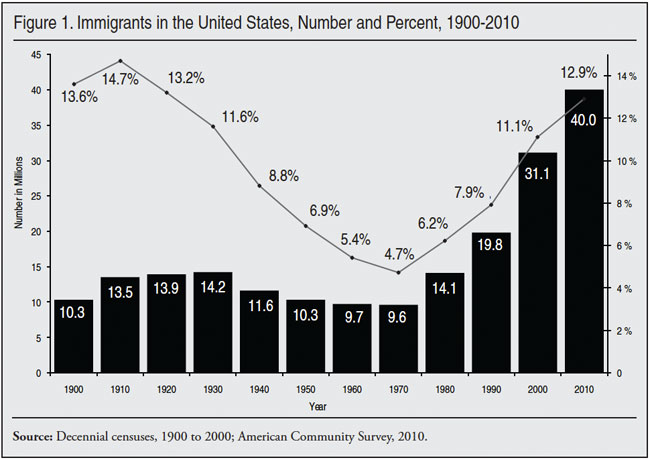03/03/2014
If the powerful of business and politics have their way, America will be burdened with a historical high percentage of immigrants.
As shown by Census figures for 2010, the United States is already headed for a record proportion of foreign-born, even without the monstrous Senate bill which doubles legal immigration and hands out millions of work permits like candy.

Forty million immigrants is clearly excessive. (Or is the number 45 million, as asserted in the article following?) Washington’s crazed open-borders policy is not what Americans want or need.
A rare honest survey on the subject shows a strong preference for sharply less immigration: Americans want legal immigration cut in half: poll, Feb 21.
Plus, America is plain full up. As the late nature photographer Ansel Adams said, “When the theater’s full, they don’t sell lap-space.”
In California, now in a historic drought, there is not enough water for those already here, as shown by growing calls for mandatory restriction. While agriculture uses the majority of water, when there is a shortage, the citizens are called upon to cut back. Millions of additional waters users would not be a good idea in California, population 38 million.
Business likes to complain that retiring boomers are leaving a worker shortage. However employers aren’t telling the whole truth about the future employment landscape: as robotics and automation perform increasingly complex tasks, humans are being phased out of many jobs. (See my article, Three Stakes in the Heart of the American Dream.)
A 2013 report from Oxford University estimated that 45 percent of American jobs will be automated within the next 20 years.
The roboticized future workplace will not require tens of millions of immigrant workers. We don’t need them.
A ‘Second Great Wave’ of immigration?, The Hill, March 2, 2014
If Congress passes immigration reform legislation this year, it will dramatically add to what the Census Bureau is calling the “Second Great Wave” of immigration in U.S. history.
Opponents of the legislation have seized on the Census Bureau’s analysis of migration patterns to warn of an explosion of foreign-born population over the next few decades.
“Once again, the country is approaching a percentage of foreign-born not seen since the late 1800s and early 1900s,” the Census Bureau wrote on its blog this week. “Will this proportion continue to increase, perhaps exceeding the high of nearly 15 percent achieved in both 1890 and 1910?”
The agency estimates that 40 million people living in the United States in 2010 were born elsewhere, approximately 12.9 percent of the population. That is the highest population of immigrants, percentage-wise, since the 1920s, according to the Census Bureau.
Opponents of granting citizenship to 11 million illegal immigrants and expanding legal immigration flows have pounced on the study.
“After 40 years of large-scale immigration, rising joblessness, failing schools and a growing welfare state, would not the sensible, conservative thing to do be to slow down for a bit, allow wages to rise, assimilation to occur, and to help those struggling here today?” Sen. Jeff Sessions (R-Ala.) said Thursday, when he delivered the keynote address to commemorate the Tea Party Patriots’ fifth anniversary.
An aide to Sessions estimated the number of foreign-born people living in the United States has now reached 45 million.
Sessions’s office estimates that number could swell by at least 30 million over the next decade if Congress passes the Senate immigration bill.
The legislation would expedite permanent legal status for an estimated 5 million people waiting for green cards and increase the number of green cards issued each year from 1 million to 1.5 million.
The Center for Immigration Studies, which opposes the Senate-passed reform legislation, estimates it would allow the foreign-born population to reach 17 percent or 65.2 billion by 2033.
The foreign-born population was less than 20 million or 7.9 percent of the total population in 1990, according to the Census Bureau.
The bureau says the first “great wave” of immigration took place between 1880 and 1930, when the foreign-born population represented between 12 and 15 percent of the total population.
The immigrant population reached a low in 1970 when 9.6 million people — 4.7 percent of the total population — residing in the United States were born in another country.
This is a content archive of VDARE.com, which Letitia James forced off of the Internet using lawfare.